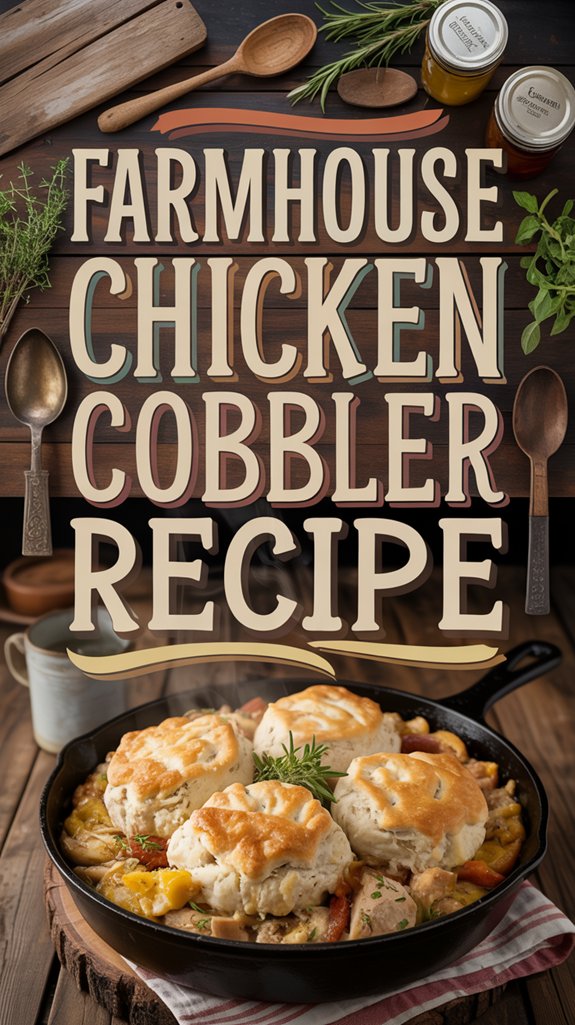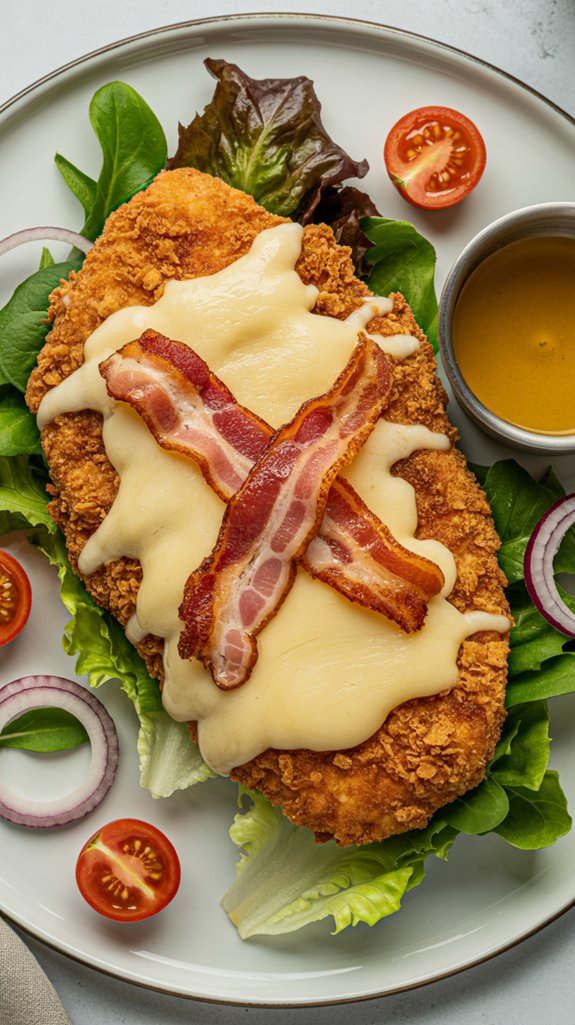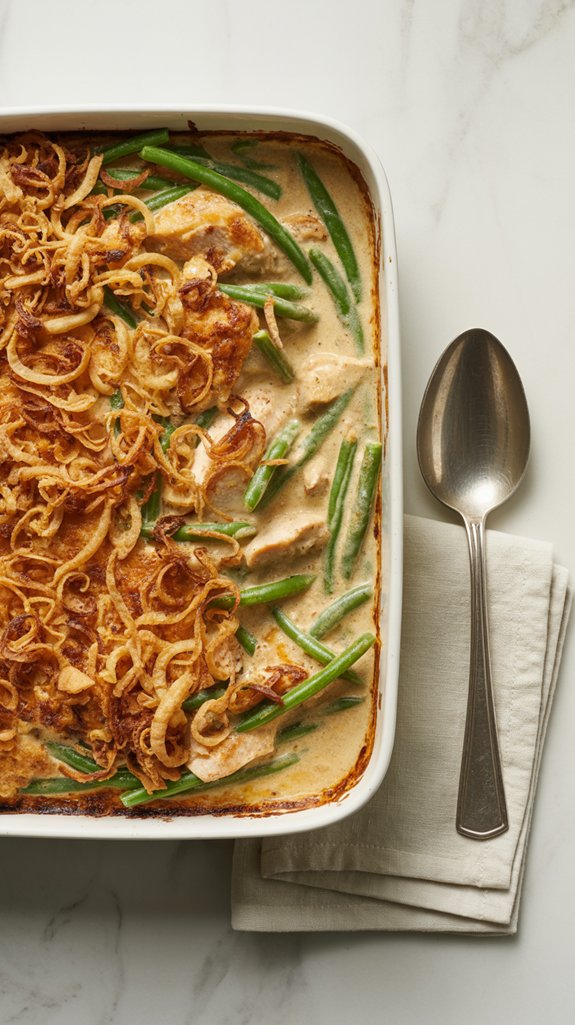Why You’ll Love This this Farmhouse Chicken Cobbler
This farmhouse chicken cobbler brings together tender chunks of chicken, fresh vegetables, and herbs in a rich, savory stew that’ll make your kitchen smell absolutely divine.
The fluffy buttermilk biscuit topping bakes up golden and perfect, creating that irresistible contrast between the creamy filling below and the slightly crispy, pillowy top.
It’s comfort food at its finest – the kind of one-dish wonder that transforms simple ingredients into something that feels like a warm hug on a plate.
Ingredients List
This farmhouse chicken cobbler comes together with ingredients you probably already have in your kitchen, making it perfect for those nights when you want something special without a trip to the store.
For the Filling:
- 3 tablespoons olive oil
- 1 leek, washed well and chopped
- Salt and ground black pepper
- 1 garlic clove, minced
- 2 cups button mushrooms, quartered
- 1 1/2 cups chicken stock
- 1 sprig fresh rosemary
- 1 bay leaf
- 2 medium carrots, peeled and cut into 1/4-inch thick coins
- 2 boneless skinless chicken thighs, diced
- 1 cup frozen peas or 1 cup fresh peas
- 2 tablespoons cornstarch
- 2 tablespoons cold water
- 2 tablespoons butter (optional)
- 2 tablespoons flour (optional)
For the Biscuit Topping:
- 1 cup flour
- 1/4 teaspoon salt
- 1/8 teaspoon baking soda
- 3/4 teaspoon baking powder
- 2-3 tablespoons butter
- 1 egg
- 1/2 cup buttermilk (or make your own with 1/2 cup warm milk plus 2 teaspoons vinegar, let stand 5 minutes)
Ingredient Considerations:
- Chicken thighs stay more tender than breasts and won’t dry out during the longer cooking time.
- Leeks need a good washing since dirt loves to hide between those layers.
- You can substitute regular milk for buttermilk using the vinegar trick mentioned above.
- Fresh peas are lovely when in season, but frozen ones work just as well and save you the shelling time.
- The cornstarch thickening is easier than the traditional roux method, but both work beautifully.
Step by Step Directions

This comforting farmhouse chicken cobbler combines tender vegetables and chicken in a rich gravy, topped with fluffy homemade biscuits for the perfect cold-weather meal. Using premium cookware sets can help ensure even heat distribution and better cooking results for this hearty dish.
Prepare the Filling:
- Heat 3 tablespoons olive oil in a large saucepan or small Dutch oven until shimmering.
- Add chopped leek, season with salt and pepper, and sauté until limp, 4-5 minutes.
- Add minced garlic and sauté until fragrant, 30 seconds.
- Add quartered mushrooms and cook until soft and most water has evaporated, 8-10 minutes.
- Add chicken stock, rosemary sprig, and bay leaf; bring to a boil.
- Add carrots and diced chicken, then lower heat to simmer.
- Cook until chicken is cooked through and carrots are nearly tender, 8-10 minutes.
- Add peas and cook 1-2 minutes more.
- Remove and discard rosemary sprig and bay leaf.
- Stir cornstarch into cold water until smooth, then drizzle into stew and stir until thickened.
- Transfer the stew to an oven-safe baking dish.
Make the Biscuit Topping:
- Preheat oven to 400°F.
- In a food processor, combine flour, salt, baking soda, and baking powder; pulse to combine.
- Add butter and pulse until mixture resembles small peas.
- Add egg and buttermilk; pulse until just combined (dough will be sticky).
- Spread dough over stew as evenly as possible, leaving a gap at edges for steam to escape.
- Bake 35-45 minutes until biscuit topping is golden brown.
Substitutions and Variations
- Dairy-free biscuit topping – Swap the butter for cold coconut oil or vegan butter, and use your favorite plant milk instead of buttermilk (add that vinegar trick to make it tangy).
- Gluten-free option – A 1:1 gluten-free flour blend works for both the thickening and the biscuits, though the texture will be a little different, more tender and less chewy.
- Make it spicier – A pinch of red pepper flakes or some fresh cracked black pepper can wake this whole thing up without overwhelming the comfort food atmosphere.
Additional Things to Serve With This Dish
This hearty cobbler is basically a meal in itself, but a few simple sides can round out the plate nicely.
- Simple green salad – Something crisp and fresh cuts through all that rich, creamy goodness. Just lettuce, cucumber, maybe some cherry tomatoes with a light vinaigrette.
- Roasted or steamed vegetables – Green beans, broccoli, or asparagus work perfectly. You want something that won’t compete with the cobbler but adds color and a little crunch.
- Crusty bread or dinner rolls – Because apparently some of us need even more carbs with our biscuit-topped casserole, and honestly, I’m not judging.
- Light soup starter – A simple tomato soup or butternut squash soup makes this feel like a proper dinner party, even if you’re just wearing sweatpants at your kitchen table.
- Pickled vegetables – Pickled carrots, cucumbers, or even just some good old dill pickles on the side help balance the richness. Your taste buds will thank you for the acidic pop.
Cooking Tips & Tricks (Chef’s Notes)
After making this recipe more times than I care to admit, I’ve picked up a few tricks that’ll save you from the mistakes I wish someone had warned me about.
- Don’t skip the mushroom cooking step – Seriously, let those mushrooms release all their water and get properly golden. Nobody wants soggy cobbler because you rushed through this part.
- Make your roux ahead of time – If you’re going the traditional route instead of cornstarch, whisk that flour and butter mixture until it’s smooth as silk. Lumpy gravy is the enemy of happiness.
- Keep your biscuit dough cold – Cold butter equals flaky biscuits, and flaky biscuits equal the difference between “this is nice” and “where has this been all my life.”
- Don’t spread the dough to the edges – I know it’s tempting to cover every inch, but that gap around the edges lets steam escape and prevents your bottom from getting soggy.
- Test your chicken pieces – Cut one open to check doneness before adding the peas. Raw chicken hiding under beautiful biscuits is nobody’s idea of a good time.
- Let it rest before serving – Give it 10 minutes to settle after it comes out of the oven. The filling will thicken up, and you won’t burn your tongue on molten vegetables.
Nutritional Facts
This hearty farmhouse chicken cobbler provides a well-balanced meal with protein, vegetables, and comforting carbs all in one dish.
- Calories per serving: Approximately 485 calories (based on 6 servings)
- Protein: 24g from chicken thighs and egg – supports muscle maintenance and keeps you satisfied
- Carbohydrates: 42g primarily from flour and vegetables – provides sustained energy
- Fat: 25g from olive oil, butter, and chicken – includes healthy monounsaturated fats
- Fiber: 4g from vegetables and whole ingredients – aids digestion and promotes fullness
- Sodium: 680mg mostly from chicken stock – moderate level for a comfort food dish
- Vitamin A: High content from carrots and peas – supports eye health and immune function
- Vitamin C: Good source from peas and vegetables – boosts immune system
- Iron: 2.8mg from chicken and flour – important for oxygen transport
- Calcium: 180mg from buttermilk and flour – supports bone health
- Potassium: 520mg from vegetables and chicken – helps regulate blood pressure
Fun “Did You Know?”
Cobbler dishes weren’t originally desserts at all – they started as savory meals during colonial America when settlers needed to stretch ingredients and create filling dishes with whatever they’d on hand.
I find it fascinating that the “cobbled” appearance of the biscuit topping gave this dish its name – it resembles cobblestones!
The beauty of cobbler lies in its flexibility; you can substitute virtually any vegetables or proteins based on what’s available.
This adaptability made it a staple for resourceful cooks who couldn’t waste food, turning humble ingredients into hearty, satisfying meals that fed entire families.





